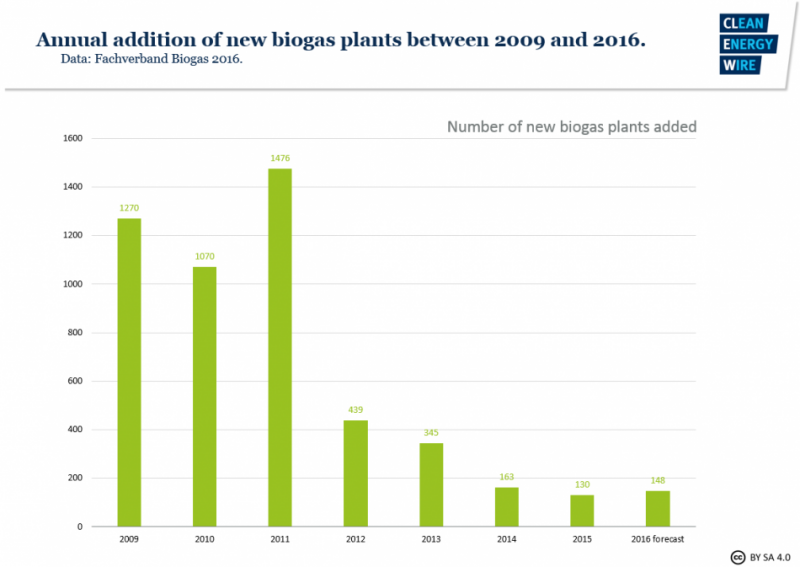Bioenergy in Germany – facts and figures on development, support and investment
The bio energy sector for power and heat production in Germany includes four different types of biomass use.
- Biogas from energy crops – Biogas power stations make up the lion’s share of Germany’s bio energy sector. There were 8,900 of them in 2015. Most of these installations use the biogas (a mixture of roughly 50 percent methane and 50 percent CO2) generated in fermenters from energy crops and manure to fire small combined heat and power plants (CHP) that feed electricity into the grid and can produce heat for a local heating network. There are also biomethane plants that include a second step, separating the CO2 from the methane to feed pure methane into the natural gas network. There were around 200 biomethane plants installed in Germany in 2019 (around 180 in 2015). The biomethane is used to produce electricity and heat in gas-fired power stations, or can be used to fuel gas-powered vehicles.
4,177 megawatts (MW) of biogas capacity was installed in Germany in 2015. Traditionally, the largest share of these installations is located in the south and north-west of Germany. In 2014 they amounted to 1,100 MW in Bavaria and Baden-Württemberg, and 1,479 MW in North Rhine-Westphalia, Lower Saxony and Schleswig-Holstein. - Biogenic waste – Biodegradable waste such as food and other organic residue can also be used to generate biogas. By the end of 2014 around 140 biogenic waste fermentation plants were operating in Germany – some upgraded their gas to biomethane.
- Solid biomass – Around 700 biomass plants that predominantly burn residual and non-recyclable waste wood to produce power and heat are installed in Germany with a capacity of 1,516 MW in 2015. Their number rose from around 20 facilities in the year 2000. A relatively new phenomenon are wood gasifiers. These very small plants in which the solid biomass is used to generate a flammable gas have mostly been installed in the past five years and have an installed capacity of only around 22 MW (2014).
- Liquid biomass – A negligible amount of power (0.39 TWh in 2015) in Germany is generated from liquid biomass such as rapeseed oil, soy bean oil or palm oil in around 180 facilities across Germany.
Power and heat production from bioenergy
In 2015 around 50 terawatt-hours (TWh) of electricity was generated from bioenergy (total gross power production in Germany was 645.6 TWh, of which 187 TWh was from renewable sources). The largest share of bioenergy (30.1 TWh, ca. 62%) was produced from the 8,900 biogas plants, followed by solid biomass like wood (11 TWh) and biogenic waste (5.8 TWh).
Renewables covered 31.6 percent of Germany’s gross power consumption in 2015. Of all renewables, bioenergy had the second largest share (8.5%), after wind power (13.3 %), and followed by solar PV (6.5%). Biogas and biomethane contributed 5.3 percent.
Renewable sources provided 157.8 TWh in heat in 2015. Of that, bioenergy contributed the largest share (88%). Solid biomass contributed the lion’s share of 106 TWh, followed by biogas (16 TWh) and biogenic waste (11 TWh). The overall contribution of bioenergy to final energy consumption for heating and cooling from renewable sources was 13.2 percent in 2015.
Development
Since 2000, power production from biomass has grown tenfold in Germany.
In the biogas sector most additions were made in 2009 and 2011, with development dwindling thereafter. (See figures below).
Financial support
Biomass installations received the second largest share of feed-in tariffs payable on German power prices in 2015. Of the 6.17 cents per kilowatt-hour paid by consumers in renewable levies, 2.66 cents went to solar PV installations, 1.57 cents to biomass plants and 1.17 cents to onshore wind turbines.
Payments for electricity to bioenergy producers under the Renewable Energy Act amounted to 6.2 billion euros in 2015, the German Association of Energy and Water Industries (BDEW) estimates, compared to 4.6 billion to onshore wind and 10.6 billion to PV installations.
With the 2014 reform of the Renewable Energy Act, support for traditional biogas plants was significantly reduced, leading to a decline in newly installed facilities. Small manure-based biogas plants and those using biogenic waste for biogas production are exempt from the cut in funding, as the government wants to promote them over the use of energy crops.
New installations run with liquid biomass have not received feed-in tariffs since 2012.
Investment in bioenergy
Of the 15 billion euros invested in new renewable installations in Germany in 2015, 1.9 billion euros were used to build new bioenergy facilities, or make additions to existing ones. Of this, around 1.4 billion euros went into heat-generating projects and 0.5 billion euros was used for electricity-generating installations.
The Ministry for Economic Affairs and Energy also publishes data on economic stimuli from the operation of renewable energy plants. This includes the turnover of companies providing services and fuel to renewable installations. In 2015 the economic stimuli from renewable energy plants amounted to 14.7 billion euros. Of that, 9.9 billion euros was generated in the bioenergy sector (4.5 billion by electricity-generating and 2.9 billion by heat-generating facilities, 2.5 billion for biofuels).
CO2 savings through bioenergy
In 2015, Germany avoided the emission of 156.1 million tonnes CO2 equivalents by using renewable energy in the heating, power and transport sectors. Germany’s total greenhouse gas emissions are estimated at 908 million CO2 equivalents in 2015. The use of bioenergy helped to avoid 61.3 million tonnes of CO2 equivalents.








